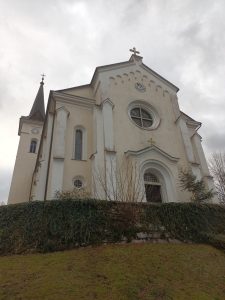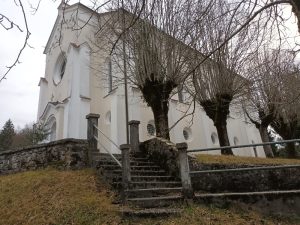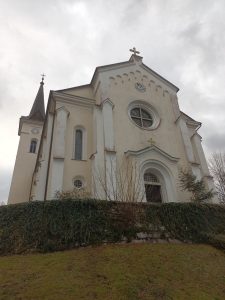Romarska cerkev
Cerkev Marijinega vnebovzetja pri Fari je bila zgrajena med letoma 1858 in 1864. Zgradili so jo arhitekt Peter Cividini ter italijanski mojstri. Nahaja se na terasi severno-zahodno od vasi Fara in je izrazita prostorska dominanta. Sodi v arhitekturo in je zgrajena iz kamna … Stavba je nastala v neoromanskem slogu.

Slika 1: Cerkev v Fari (Vir: Anamari Jurjevič)
Stavba je namenjena verskim molitvam ter obredom. Je romarska/katoliška cerkev.
Današnja cerkev stoji na istem mestu kot starejša predhodnica, ki je bila zgrajena okoli leta 1363. V seznamu cerkvenih dragocenosti na Kranjskem iz leta 1526 je že navedena kot župnijska cerkev. Kot navaja Resman B. : »Okoli cerkve naj bi stalo obzidje s tremi obrambnimi stolpi. Do leta 1418 so imeli pravice najprej Ortenburžani, do leta 1456 Celjski in nato še Habsburžani.« Ko je bila cerkev požgana leta 1741 je bila popravljena začasno. Senjski škof jo je na novo posvetil 5. oktobra 1747. Nasproti Rožnovenske kapele so želeli s cerkvenimi prihranki zgraditi novo kapelo in vanjo prestaviti oltar. 6. septembra 1757 je cerkev skoraj v celoti pogorela. Cerkev je bila v tako slabem stanju, da bi se lahko vsak čas podrla. Zato so leta 1832 prosili za novo saj so ljudje hoteli biti v stiku z bogom in moliti a ker v bližini ni bilo tako velike cerkve niso imeli kje. Leta 1838 se je novomeški okrajni inženir odločil, naj se na mestu stare zgradi novo cerkev.
 Notranjščina je triladijska in to tako, da sta nad stranskima ladjama odprta hodnika ali empori. Oprema je sicer že skromnejša kakor v baroku, a vendarle lepa. Posebno bogastvo in lepoto predstavljata dve sliki, delo Pavla Künla: v glavnem oltarju Marijino vnebovzetje, v stranskem pa slika sv. Ane. Vse okrasje v cerkvi kaže na ljubezen, ki so jo prifarski in drugi verniki, ki so poromali sem, izkazovali nebeški zavetnici Materi božji.
Notranjščina je triladijska in to tako, da sta nad stranskima ladjama odprta hodnika ali empori. Oprema je sicer že skromnejša kakor v baroku, a vendarle lepa. Posebno bogastvo in lepoto predstavljata dve sliki, delo Pavla Künla: v glavnem oltarju Marijino vnebovzetje, v stranskem pa slika sv. Ane. Vse okrasje v cerkvi kaže na ljubezen, ki so jo prifarski in drugi verniki, ki so poromali sem, izkazovali nebeški zavetnici Materi božji.

Slika 2: Cerkev v Fari (Vir: Anamari Jurjevič)
Neoromanski slog se zgleduje po romaniki srednjega veka in jo prilagodi sedanjemu času.
Lega cerkve se mi zdi praktična in zanimiva ter je največja od cerkev v bližini. Notranjščina se mi ne zdi posebna, edino slika uprizoritve Marijinega vnebovzetja se mi zdi lepa, ki je za oltarjem.
Anamari Jurjevič, 2. a (šolsko leto 2022/23)
VIR IN LITERATURA:
- Resman, B. (2010). Upravna enota Kočevje. Ljubljana: Založba ZRC.
- Svetik, P. (2001). Kostelski biseri: kulturna dediščina in naravna vrednota pokrajna Kostel. Kostel: Turistično-športno društvo Kostel.
- Fara – Marijinega vnebovzetja. (b. l.). Besedilo dostopno 10. 11. 2022 na spletni strani: https://eid.gov.si/#!/enota/1806
Parish Church of the Assumption of Virgin Mary in Fara
Romanesque church
The Church of the Assumption of Virgin Mary in Fara was built between the years of 1858 and 1864. It was designed by the architect Peter Cividini and built by Italian craftsmen. It is located on a terrace northwest of the village of Fara, and it is a distinct spatial landmark. It belongs to the field of architecture and is primarily constructed of stone. The building was erected in the neo-Romanesque style.

Picture 1: Church in Fara (source: Anamari Jurjevič)
The building serves as a site for prayer and religious ceremonies, and it functions as a pilgrimage and Catholic church. Today’s church stands on the same spot as its predecessor, which was built around 1363. It was already recognised as a Parish church and listed among the religious gems of Carnolia as early as 1526. As quoted by Resman B.: “The walls with defensive towers should stand around the church. The rights were first given to the Ortenburgers until 1418, then passed to the Counts of Celje until 1456, and eventually to the Habsburgs.” After the church burnt down in 1741, it was restored temporarily. It was rededicated by the Bishop of Senj on the 5th of October 1747. They wanted to build a new chapel opposite the Rosary Chapel using the church’s savings, and move the altar into it. On the 6th of September 1757, the church burnt down almost completely. The building was in such a bad state that it could have collapsed at any time. Therefore, in 1832, the community asked for a new church because they wanted to maintain the connection with God through prayer and worship. Additionally, there was a great need for a church of sufficient size as there were no proper alternatives available nearby. In 1838, the district engineer from Novo mesto decided to construct a new church on the same site as the old one.
The interior features three church naves, with an open church nave or emporia above the two side church naves. The furnishings are more modest compared to the Baroque period, but they are beautiful nevertheless. Two paintings by Paul Kunl are of particular richness and beauty: the Assumption of the Virgin Mary behind the main altar, and the painting of St. Anne. All the decorations within the church reflect the love and devotion that the faithful people of Fara as well as other pilgrims have shown towards the Heavenly Patroness, the Mother of God.

Picture 2: Church in Fara (source: Anamari Jurjevič)
The neo-Romanesque style takes inspiration from the Romanesque art of the Middle Ages and adapts it to the present.
I find the location of the church practical and interesting, and it is the largest of the churches in the vicinity. I don’t find the interior special, the only thing I find beautiful is the painting of the Assumption of Virgin Mary, which is located behind the altar.
Anamari Jurjevič, 2. a (School Year 2023/24)
SOURCE AND LITERATURE:
- Resman, B. (2010). Upravna enota Kočevje. Ljubljana: Založba ZRC.
- Svetik, P. (2001). Kostelski biseri: kulturna dediščina in naravna vrednota pokrajna Kostel. Kostel: Turistično-športno društvo Kostel.
- Fara – Marijinega vnebovzetja. (b. l.). Besedilo dostopno 10. 11. 2022 na spletni strani: https://eid.gov.si/#!/enota/1806